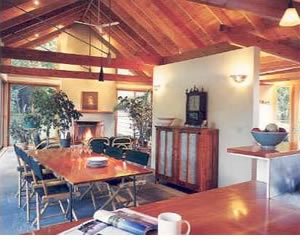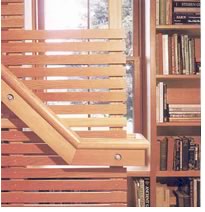

The Distinctive Home: A Vision of Timeless Design
by Jeremiah Eck, FAIA (Taunton Press, 2003)

Reviewed
by Stephanie Stubbs, Assoc. AIA
Managing Editor
“Distinctive houses avoid the sameness, blandness, and thoughtlessness of many new houses being built today,” writes respected residential-design veteran Jeremiah Eck, FAIA, in his new book The Distinctive Home: A Vision of Timeless Design. “They are situated on their plots in the best possible way, present an honest and dignified face to the world, arrange rooms to make domestic life convenient and comfortable, and are sensuously and spiritually satisfying inside and out.”
 Armed
with these universal design truths, the architect spirits us on an odyssey
of beautiful house design, some 50 exquisitely detailed projects by 30
architecture firms, most based in the Northeast. The book, published by
Taunton Press and aimed toward the interested lay audience, has that “Taunton
look” we have come to know and admire: clean, generously spaced
layout; beautifully relevant, well printed photographs; and meticulously
edited and referenced text. In fact, The
Distinctive Home also bears the distinctive mark of the first book
published under a new collaborative imprint between the AIA and Taunton
Press. Under this imprint, AIA members will author books detailing good
architecture and design practices for potential clients, interested lay
audiences, and all kinds of architecture lovers. It appears that architects
with better informed and inspired clients will end up being the happiest
beneficiaries of this arrangement.
Armed
with these universal design truths, the architect spirits us on an odyssey
of beautiful house design, some 50 exquisitely detailed projects by 30
architecture firms, most based in the Northeast. The book, published by
Taunton Press and aimed toward the interested lay audience, has that “Taunton
look” we have come to know and admire: clean, generously spaced
layout; beautifully relevant, well printed photographs; and meticulously
edited and referenced text. In fact, The
Distinctive Home also bears the distinctive mark of the first book
published under a new collaborative imprint between the AIA and Taunton
Press. Under this imprint, AIA members will author books detailing good
architecture and design practices for potential clients, interested lay
audiences, and all kinds of architecture lovers. It appears that architects
with better informed and inspired clients will end up being the happiest
beneficiaries of this arrangement.
Ordered construct
Eck, a passionate theorist who practices what he preaches, offers four
main constructs for creating the distinctive home:
1. Site: Marrying a house to the land
2. Floor plan: Expressing the way you live
3. The public face: Balancing function and beauty
4. Details: The intimate realm.
“It’s possible to create a distinctive house anywhere, whether you’re on a seacoast or in a subdivision, and you can do it without spending a fortune,” Eck declares. He begins his book with a personal and endearing description of what these concepts mean to him, and illustrates his ideas through thoughtfully chosen examples. “I’ve always believed that there are a few critical details, like fireplaces, that mean the most to us. I try to include at least one of these special details in every house I design,” Eck writes. “This notion also applies to older houses. If you do only one thing to improve your current house, you should lovingly work on a detail like this and make sure it expresses the artistic quality you seek in the house.”
 The
author uses the remainder of his tome to explain and illustrate site,
plan, and details.
The
author uses the remainder of his tome to explain and illustrate site,
plan, and details.
Site: Marrying a house to the land
“Thoughtful siting takes time,” Eck explains. “It means
getting intimate with the land, walking its boundaries, peering into its
foliage, and visiting it at different times of day or in different seasons,
if possible.” He defines how to start with aerial views, and zoom
in at increasingly greater scales. He talks about the calculable, such
as dealing with topography, and counters with the intuitive, such as the
importance of first impressions. “After taking into account all
the many influences involved in siting a house—sunlight, views,
topography, privacy—I begin to dream a bit, giving my first impression
time to grow,” he writes. He also covers the more mundane but equally
important topics of dealing with suburban lots, setbacks, and showing
respect for the neighborhood.
 Floor
plan: Expressing the way you live
Floor
plan: Expressing the way you live
Eck begins his floor-plan discussions by asking if Mount Vesuvius were
to erupt in a suburban neighborhood, what would archeologists a millennium
hence think about the typical house? He posits that the living room and
dining room would lead them to conclude that we do a lot of formal entertaining
(not for the last half-century!) and that they would never be able to
discern the function of the family room. The point is that houses, even
the bulk of structures being built today, do not closely mirror our lifestyles
anymore. He proposes to the client an alternate way of thinking about
house design, one that architects know well: Instead of starting with
traditional rooms (“Where do you want the living room?”),
think about function: Where do you spend most of your time in the house?
What are the ideal qualities of the spaces that are the most important
to you? He leads readers through a discussion of formal vs. informal spaces,
marrying the plan to the site, and then from bubble diagram to floor-plan
types.
 The
public face: Balancing function and beauty
The
public face: Balancing function and beauty
You might think of this chapter as the “big details” section.
The author cautions about labeling a dream house with historic styles;
he finds it limiting, as “a house can have many styles, what I prefer
to call personalities,” he writes. “Rooflines, materials,
colors, chimneys, porches, entries, and trim details can transmit all
kinds of messages about the nature and quality of the house.” He
discusses the difference between scale and massing, as well as techniques
for scaling up or down. Moving on to components, Eck touches on the topics
of fenestration, texture and pattern of building skin, and “The
Roof: A Hat for Home.”
 Details:
The Intimate Realm
Details:
The Intimate Realm
Perhaps the most fun of all, this chapter comprises the “little
details” section; the ones in which the divine resides. Eck quotes
the well-known (to architects, anyway) teaching of Eero Saarinen that
looks at the “next highest order of context” for design solutions:
a door for the door handle design, a wall for a door design, a room for
a wall design, etc. He draws on the “power of materials” when
he says, “Details tend to work best when they are designed so that
the natural qualities of the materials are revealed in some way,”
declaring it the truth for vinyl siding as well as wood. True to architect
form, he speaks of the harmony of tying the pieces into a whole. Finally,
Eck concludes that “a house is a balance of aesthetics, practicality,
and affordability. Priorities must be set and choice must be made…in
my mind, there are three interior details that can really make a difference—I
like to call them the holy trinity: stairs, fireplaces, and built-ins.”
Quibbles about the book prove few and nowhere close to overpowering in the grand scheme of things. Although the book offers many and varied examples of distinctive homes, it is unabashedly New England-centric and would perhaps have benefited from a drop of adobe and a sere landscape or two. Second, the architects of the projects are clearly named, but in a separate list in the back. It’s distracting to keep flipping back and forth to see who did what; credits in the captions would go a long way. Nonetheless, Eck has touched the soul of residential design: The Distinctive Home looks like the beginning of a beautiful friendship between the AIA and Taunton Press, to the delight and benefit of architects and clients alike.
Copyright 2003 The American Institute of Architects.
All rights reserved. Home Page ![]()
![]()
 |
||
| You can purchase The Distinctive Home from the AIA Bookstore, ($36 AIA members/$40 retail, plus $9 shipping and handling.) To order, phone 800-242-3837, option #4; fax 202-626-7519; or send an email. Jeremiah Eck will be a special guest at the AIA Grassroots and Leadership Conference, March 9. He graciously has agreed to autograph copies of his book at the AIA national component’s bookstore, during the Institute’s open house, 6–8 p.m. Call the bookstore, 800-242-3837, option #4, for details.
|
||